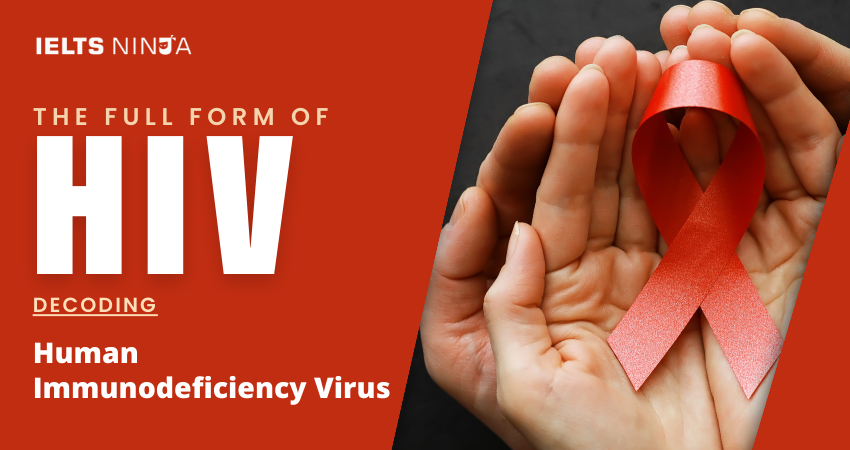In the field of medicine and public health, the full form of HIV is an abbreviation that stands for Human Immunodeficiency Virus. HIV is a virus that attacks the immune system, specifically targeting CD4 cells, which play a crucial role in the body’s defense against infections. If left untreated, HIV can lead to the disease known as Acquired Immunodeficiency Syndrome (AIDS), which is characterized by a weakened immune system and increased vulnerability to opportunistic infections and certain cancers. In this comprehensive guide, we will explore the details of HIV, its modes of transmission, symptoms, prevention, and the global impact of the HIV/AIDS epidemic.
What is HIV?
HIV is a retrovirus that infects and gradually destroys CD4 cells (T cells), which are vital for a healthy immune system. When the immune system is severely damaged, the body becomes susceptible to a wide range of infections and illnesses.
Modes of Transmission -HIV
HIV is primarily transmitted through the following modes:
- Unprotected Sexual Contact: The virus can be transmitted through unprotected vaginal, anal, or oral sex with an infected person.
- Sharing Needles: Sharing needles or syringes with an infected person, commonly associated with drug use, can transmit HIV.
- Mother-to-Child Transmission: HIV can be transmitted from an infected mother to her child during childbirth or through breastfeeding.
- Blood Transfusions: Although rare, HIV transmission can occur through blood transfusions with contaminated blood or blood products.
- Occupational Exposure: Healthcare workers may be at risk of HIV transmission through needlestick injuries or contact with infected blood.
Symptoms of HIV
The symptoms of HIV infection can vary and may include:
- Fever
- Fatigue
- Swollen lymph nodes
- Sore throat
- Skin rash
- Muscle and joint pain
- Headache
- Night sweats
- Diarrhea
- Mouth sores
- Rapid weight loss
These symptoms may appear within a few weeks to months after infection and can last for a few weeks. However, some individuals may not experience noticeable symptoms for years.
Stages of HIV Infection
HIV infection progresses through several stages:
- Acute HIV Infection: The initial stage, often characterized by flu-like symptoms.
- Chronic HIV Infection: The virus continues to replicate but at lower levels. This stage can last for many years.
- AIDS: When the immune system is severely damaged, and the CD4 cell count drops below a certain level, the condition is diagnosed as AIDS. At this stage, the body struggles to fight off infections and illnesses.
Prevention from HIV infection
Preventing HIV infection involves several key strategies:
- Safe Sex: Practicing safe sex by using condoms and engaging in monogamous relationships can reduce the risk of transmission.
- Pre-Exposure Prophylaxis (PrEP): PrEP is a medication taken by individuals at high risk of HIV to prevent infection.
- Needle Exchange Programs: Providing clean needles to individuals who use injectable drugs reduces the risk of transmission.
- Early Testing and Treatment: Early detection and antiretroviral therapy (ART) can slow the progression of HIV and reduce the risk of transmission.
- Preventing Mother-to-Child Transmission: Pregnant women with HIV can take medications to reduce the risk of transmission to their infants.
Also Read: Best online IELTS coaching & training academy
Global Impact on HIV
HIV/AIDS has had a profound global impact:
Epidemic:
The HIV/AIDS epidemic has affected millions of people worldwide, particularly in sub-Saharan Africa.
Stigma and Discrimination:
Stigma and discrimination against people living with HIV/AIDS remain significant barriers to prevention, treatment, and care.
Advances in Treatment:
Advances in antiretroviral therapy have significantly improved the outlook for individuals living with HIV, allowing them to lead healthy lives.
Conclusion
HIV, or Human Immunodeficiency Virus, is a virus that affects the immune system and, if left untreated, can progress to AIDS. While there is no cure for HIV, advances in treatment and prevention strategies have transformed HIV/AIDS from a once-deadly disease into a manageable condition. Raising awareness, promoting safe practices, and expanding access to testing and treatment are crucial in the global effort to combat HIV/AIDS.








